Beetles
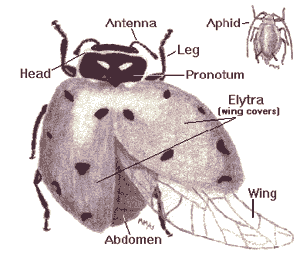 The beetles are a large and diverse group of insects. Beetles exhibit complete metamorphosis with egg, larval, pupal and adult stages. All beetles have 2 pairs of wings. The first (outer) set of wings are hard protective covers called elytra. The elytra cover the clear, membranous second pair of wings. Beneficial species of beetles are typically predaceous as both larvae and adults.
The beetles are a large and diverse group of insects. Beetles exhibit complete metamorphosis with egg, larval, pupal and adult stages. All beetles have 2 pairs of wings. The first (outer) set of wings are hard protective covers called elytra. The elytra cover the clear, membranous second pair of wings. Beneficial species of beetles are typically predaceous as both larvae and adults.
At right, lady beetle anatomy; below, lady beetle larva anatomy.
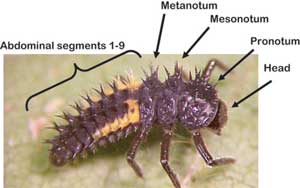
| About lady beetles - Coccinellidae |
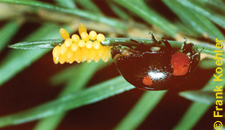 |
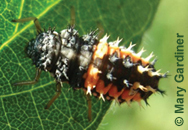 |
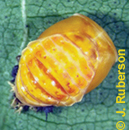 |
| Eggs: Oval. Orange to yellow in color. Deposited in clusters. Above, an adult lays eggs. | Larvae: Often alligator-shaped. Typically black or gray with light markings. May be covered with flexible spines. | Pupae: Oval. Resemble adults in coloration. May look wrinkled. Often found attached to plant leaves or stems. |
Learn more about lady beetles:
- Convergent lady beetle, Hippodamia convergens
- Multicolored Asian lady beetle, Harmonia axyridis
- Parenthesis lady beetle, Hippodamia parenthesis
- Pink lady beetle, Coleomegilla maculata
- Red lady beetle, Cycloneda munda
- Seven-spotted lady beetle, Coccinella septempunctata
- Thirteen-spotted lady beetle, Hippodamia tredecimpunctata
- Two-spotted lady beetle, Adalia bipunctata
- Variegated lady beetle, Hippodamia variegata
Additional resource: The University of Minnesota's diagnostic guide to lady beetles by Nancy Schellhorn.
| About ground beetles - Carabidae |
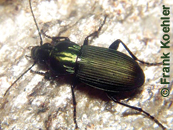 |
 |
| Metallic ground beetle. | Black ground beetle. |
Adults: Usually dark and shiny with threadlike antennae. Color varies – commonly black, brown or metallic. Abdomen often much wider than the head or pronotum. Elytra may have striations or pits. Length: 3-25 mm.
Eggs: Deposited singly in or on the soil surface. Small, difficult to see. Number per female varies widely among species.
Larvae: Segmented, tapers from head to tail. Head large with well-developed jaws.
Pupae: Pupate in the soil.
Diet: Eggs and larvae of root maggots, caterpillars, aphids, beetle larvae and weed seeds.



 Print
Print Email
Email